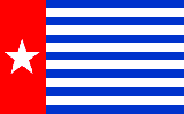“This dance tells the story of two brothers who were long separated, divided by sea, meeting again as adversaries during a time of war. They did not recognize each other and began to fight, resulting in the death of one of the brothers. After seeing his fallen foe close up, the victor realized he had just killed his brother. With deep regret, the dead brother’s body was lifted and carried by a group of fighters wailing and crying with grief, the body taken by boat to be returned home.”
And
so goes Fakfak local Abas Bahamba’s summary of the Yawa dance of the
people of Karas, a small island in the eastern part of Fakfak regency in
West Papua. Starting with the simple strumming of a guitar and the
beating of a small drum, then the voices of five women in song, this
dance of coastal life, of departure and of grief is evocative and
haunting.
Singing repeated refrains of “kyaun yallarat naramde ed
loi tirried” or “brother paddle the boat quickly” and “in sebotkin loi
koure edtirried innarurik” or “ready to depart the wind is blowing the
boat has left” in the Karas language, the languid melody accompanied
male dancers who paddle the deep, battle with spears in hand and wail in
mourning over a brother killed.
Performed during the festivities
for Fakfak’s 112th birthday, the Yawa left onlookers simultaneously
moved into quiet introspection and humming.
That evening
culminated in a performance almost shockingly postmodern, featuring
dancers clad and painted in clearly self-referential tribal dress and
doing what can only be described as a Papuan version of Michael
Jackson’s “Thriller” with a splash of Bollywood.
Popping and
locking as well as crawling and scampering to remixes and samples of
techno and dance tunes with some dangdut thrown in, the performance by
the Imeko clan from Manokwari regency — clearly influenced by Papuan
choreographer Jecko Siompo — tossed so-called traditional dance out the
window in favor of innovation and ingenuity. And all to the complete
delight of the audience, who grinned and laughed at the corporal
expertise mixed with antics on stage.
But perhaps the most
memorable of all the dances performed in Fakfak last week was the Seka
of the Kamoro people, involving slow intentional movements that climaxed
with the dancers bending their knees and slowly crouching, eventually
bouncing on their haunches in a test of muscle strength and balance.
Not
letting the handful of women enjoy themselves alone, the Seka reigned
in all onlookers and created a street party of laughing, squatting,
hunkering people. That night’s festivities concluded with the audience
dancing in Fakfak’s main street to a band of drummers, a guitarist and
one of the Mbaham Matta clan leaders playing ukulele, people undulating
and swaying in rows down the street into the sparkling, still evening.
